April 9, 2018
An unglamorous sewage health crisis gets an
inadequate proposed solution
Seriously, they want to do this. The ravine in Lincoln Park used to be the bed of the Beaverkill before the river was buried underground in a big pipe sometime in the 19th Century. One hundred years ago the ravine was a tourist attraction, something that people actually travelled to Albany to see and experience. Postcards of the ravine are still common at book and ephemera fairs. Now they want to fill in the ravine so it is gone forever.
 Postcard Marked 1911 Looking Down Into The Ravine In Lincoln Park (Then Called Beaver Park)
Postcard Marked 1911 Looking Down Into The Ravine In Lincoln Park (Then Called Beaver Park)
The reason? The City wants to put an automated sewage treatment plant on one end of the ravine and level off the rest, turning that part into, oh, something, a meditation garden or a pond or whatever. They want us folks who live nearby to offer ideas about what ought to go in that leveled off part and not think too much about the sewage treatment plant jammed into the middle of a venerable public park within sight of the Martin Luther King monument and forget about the disappearing ravine.
The cost of the Beaver Creek Screening and Disinfection Facility, we are told, will be $45 million of mostly State money, a mere pittance for these sorts of things, and the project will take 3 years to complete with work starting next year. There will be mess and disruption in the park for all that time. And although they assure us the community garden on the MLK Boulevard end of the ravine will remain, it is obvious that it will have to be abandoned during the three years of construction.
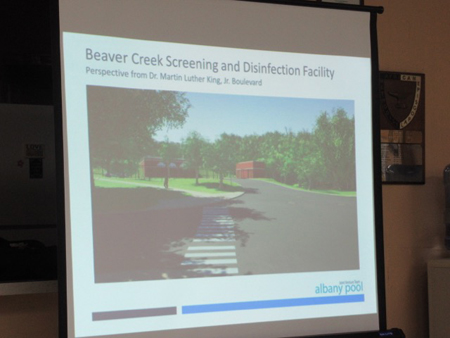 Best Picture I Could Get Of The Proposed Facility, From A Presentation At The Hudson Park Neighborhood Association, MLK Monument To The Left
Best Picture I Could Get Of The Proposed Facility, From A Presentation At The Hudson Park Neighborhood Association, MLK Monument To The Left
This plan is being presented to us as better than nothing, the absolute minimum that is more than good enough for those of us who live in the South End. It all started with a persistent stink emanating from an iron aeration grate on one end of the ravine in Lincoln Park, a grate installed sometime in the middle of the 20th century. It lets out an odor of rotting sewage that drives most people out of the ravine gagging and retching. Old timers have told me that it has been stinking up the park as long as they could remember, and, they say, in recent years it has been getting much worse.
From time to time folks who live around the park would complain about the odor emanating from both the grate and from nearby manholes especially after heavy rains, but the elected officials would shrug and pointedly ignore us. After all, they didn’t have to smell it. And besides, successive City Hall administrations absolutely did not want to deal with what they knew all along to be an unglamorous and expensive problem that apparently only affected the unimportant and despised citizens of the South End.
 Another View From The Same Meeting
Another View From The Same Meeting
Now, I hate to congratulate myself (I’d rather someone else did but that’s unlikely) but I started to figure out that this stinking grate on the edge of my neighborhood is part of a massive health and infrastructure problem that stretches right across the City of Albany and into the Hudson River, directly and immediately affecting the quality of life and the health of tens of thousands of people. The more I figured out what was going on under our feet the more it became clear to me that this was a serious crisis.
So in the second half of the last decade I started my own political stink that rivaled the sewage odor in my neighborhood park, the odor that billowed out from the grate and from nearby manhole covers and made people spit tears of revulsion. At first I was totally ignored. In 2008 I attended a public hearing about sewers and storm drains put on by the Capital District Regional Planning Commission (CDRPC) and got a chance to study a comprehensive map of the underground drainage system in the City of Albany. To my astonishment the Beaverkill storm drain line wasn’t even on the map!
Seriously. I kept asking where it was and the experts in attendance acted like they had no idea what I was talking about. I still to this day cannot understand how they could map out the drains and not indicate the line that carries some 70% of the storm water runoff in the City. Those maps have since been amended, and I’m sure there would be universal denials that anyone ever ignored this vital underground waterway.
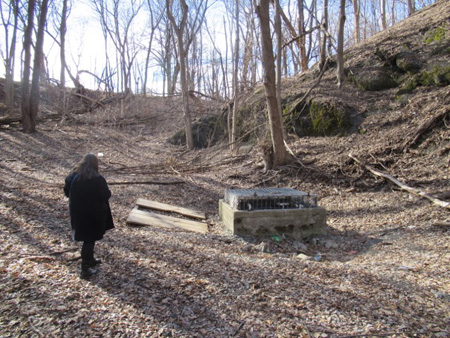 The Stinking Aeration Grate On The Far End Of The Ravine
The Stinking Aeration Grate On The Far End Of The Ravine
But there was indeed a conspiracy of silence up to that point, nothing elaborate, just the most simple, basic and stupid kind of conspiracy that is common among politicians. It seems that the then administration of former mayor Jerry Jennings, who operated as a complete dictator, had chosen to pretend that this crisis did not exist. In fact, he kept it secret from the State. My guess is that he did not want to expend political capital on such an unglamorous problem, along with not wanting to look for and spend money that could better be distributed as graft.
So after describing on this blog back in 2009 what I had figured out, and occasionally publishing photos of raw sewage floating out of the outflow pipe of the Beaverkill directly into the Hudson River, certain State and regional authorities began to take notice of this problem. But not Jerry Jennings. In his latter years as mayor he switched from pretending the problem didn’t exist to active denial and sabotage.
You see, starting way back in 2007 the CDRPC began putting together a plan among six local communities along the upper Hudson River to address water quality issues with sewer and storm drain runoff that were adversely affecting the river. Its official name is the Albany Pool Communities Combined Sewer Overflow Long Term Control Plan. it was a long overdue State sponsored effort to deal with overlooked pollution of the river that had been going on in some cases for more than a century.
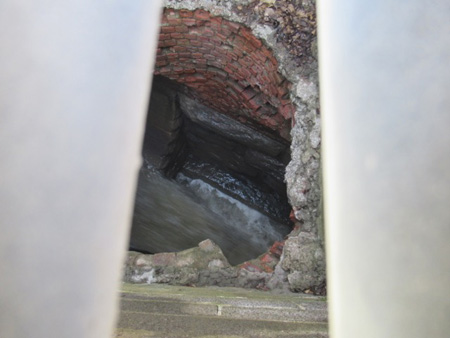 The Roaring Beaverkill Inside The Grate, As Can Be Seen The Chamber Is Disintegrating
The Roaring Beaverkill Inside The Grate, As Can Be Seen The Chamber Is Disintegrating
But Jennings did something very strange. He let the CDRPC know all about the problems with the Patroon Creek in the northern part of the City of Albany, which carries runoff from the Rapp Road Dump. But he did not say one word to them about the very existence of the Beaverkill, let alone the constant outflow of raw sewage into the Hudson.
It was a bizarre silence. Riverkeeper reported that water samples in the Hudson directly downstream from the outflow for the Beaverkill, the “Big C Pipe,” had grossly elevated levels of dissolved human shit year round, and in high summer vast amounts of fecal bacteria in the water. You know, the stuff that lives in your lower intestine. Yet until recently the State authorities and the local Corporate Media refused to acknowledge the source of the pollution. I kept reading Corporate Media reports that the high levels of sewage waste detected in the Hudson along the South End waterfront was caused by “water swirling around by the Port.” Seriously. That was their oft repeated phrase.
So as a result, when a Pool Communities draft plan was put together for the six communities there was no mention of the Beaverkill. The idea of the plan was for the communities to each kick in a certain amount of money, which required quite a bit of negotiation, and the State would provide the rest. The cash resources would be “pooled” together, thus the probably unintended pun. But originally no money was to be directed at the biggest source of pollution of them all.
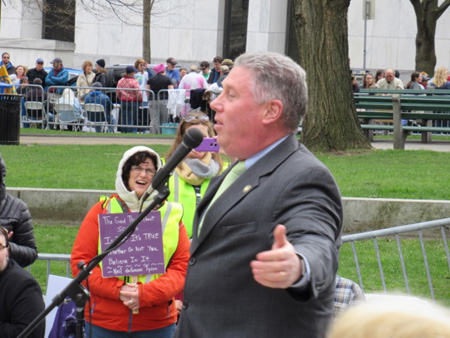 NY State Assembly Member John McDonald Speaking At The Science March In Albany, April 2017
NY State Assembly Member John McDonald Speaking At The Science March In Albany, April 2017
Fortunately, newly elected State Assembly member John McDonald came to the rescue, pointing out to the State and to the six communities the necessity of including the Beaverkill outflow in the Sewer Control Plan. The other five communities balked at this, not wanting, as they said, to pay for Albany’s problems, but the now informed State Department of Environmental Conservation (DEC) had rightly decided the Beaverkill is a priority problem and told the Pool communities they had no choice but to include the Beaverkill in the final plan.
So it fell to City of Albany water commissioner Joe Coffey, who had been appointed by newly elected mayor Kathy Sheehan, to come up with a plan to deal with the Beaverkill sewage. Now, the DEC had only one concern here, to stop the sewage floating into the Hudson. Bad smells, runoff sewage, health and quality life problems are of no interest to the State as long as those problems remain confined to the South End of the City of Albany.
It is important to understand this attitude of the State, which is the same as the attitude of the other five communities in the Sewer Control Plan. They see the City of Albany as an enemy that has to be opposed and defeated at every opportunity, and thus should be denied necessary resources whenever possible. Thus the State is willing to provide enough cash to prevent raw sewage from continuing to flow into the Hudson River but refuses to spend the the greater money needed to actually fix the potentially dire health problem to the Albany citizens.
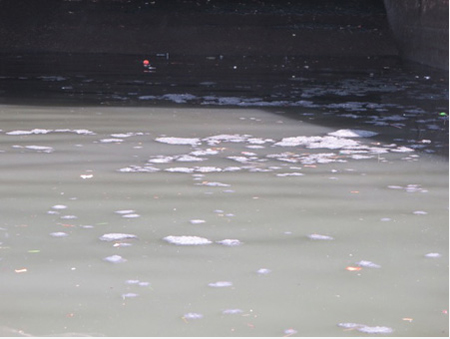 Mats Of Decayed Human Waste Floating Out Of The Big C Pipe Into The Hudson River, The Mouth Of The Beaverkill
Mats Of Decayed Human Waste Floating Out Of The Big C Pipe Into The Hudson River, The Mouth Of The Beaverkill
You see, raw sewage is not supposed to flow down a storm drain in the first place. But under the streets of Albany we have this thing called combined sewage overflow (CSO), which means that the sewer lines and the street storm drain lines are tied together at certain points. The idea, when the lines were built about a hundred years ago, was that if either the storm drains or the sewer lines got overwhelmed because of a major storm or major snow melt or too many households flushing toilets at once, the other line would be available to catch the excess water.
The mechanism for this is very simple, a few well-placed underground concrete caverns separated into two chambers by a wall that does not rise all the way to the ceiling of the cavern. Normally the sewage stays on one side of the wall and the street runoff stays on the other side. Only when there is too much water on one side will it slop over the wall into the other line. Usually this was supposed to mean the storm water joining the sewage.
But there’s a very good reason why these CSOs aren’t built anymore. Municipalities such as Albany love to have developers build new buildings, houses, apartments, commercial buildings, whatever. But the politicians don’t like to build infrastructure to support these new buildings, or even require developers to build them. And the one thing they hate to build more than anything else is new sewers, they are expensive, digging for them causes big disruptions, and they are politically unglamorous.
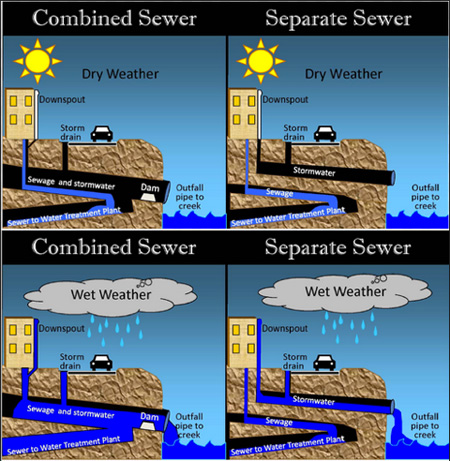 Combined Sewer Overflow Illustrated
Combined Sewer Overflow Illustrated
So as new buildings were being built uptown in the City of Albany it became convenient to let that sewage slop over the walls inside those big underground caverns and run out through the storm drain lines directly into the Hudson. Successive mayors since the mid 20th century have figured that no one was going to notice mats of decayed human shit floating out of the “Big C” pipe sticking out from under the U-Haul parking lot by the river. And they sure as hell didn’t care if the citizens of the South End had to deal with sewage stink or any potential health problems caused by seepage into the ground near their homes.
Since no one in power really cares about our health and safety here in the South End, the original proposed solution was to build a sewage treatment plant on the shore of the Hudson River in the parking lot of the U-Haul building. Of course no one bothered to discuss this with the owners and managers of U-Haul. And this of course was a big middle finger raised to the citizens of Albany, telling us that no one cares that you are wallowing in sewage, as long as the river is kept clean.
But it appears this plan was discarded. The reason I heard was because there is a City ordinance that does not allow sewage treatment plants to be built on the riverside flood plain, which makes perfect sense. Of course this does not disallow the sewage treatment plant that exists a little ways to the south of the U-Haul building next to the Port of Albany. So I’m thinking that citing the ordinance is merely an excuse for a sudden burst of practicality and common sense.
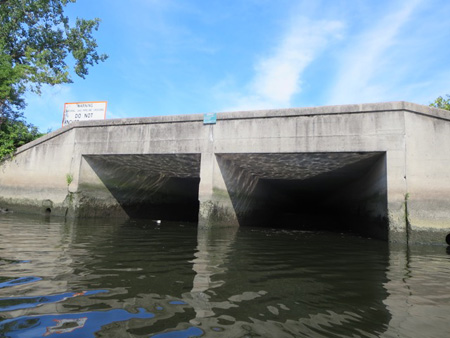 The Big C Pipe, The Mouth Of The Beaverkill Under The U-Haul Building Parking Lot
The Big C Pipe, The Mouth Of The Beaverkill Under The U-Haul Building Parking Lot
Thus we have this proposal to put the facility further upstream inside the ravine in Lincoln Park. It’s supposed to be automated and therefore we are told it will be low impact, quiet, odorless, barely visible because most of it will be underground. Well, hopefully it will be low impact after three years of construction. That’s what we’re being told.
But I have two big objections to this plan. The first problem is that this does not take care of sewage running down the Beaverkill coming from the west into Lincoln Park. In effect, the Beaverkill storm drain runoff line beyond the park will become a dedicated sewer line. But it will continue to be a storm drain runoff. That does not sound like a solution to me.
The Beaverkill has another very important function, it is the outflow runoff for Washington Park Lake, which is actually the Beaverkill daylighted. But wait (you might say) the lake is not filled with sewage. However, by the time the outflow from the lake gets to the grate in Lincoln Park the stream is lousy with sewage. Where does the sewage come from?
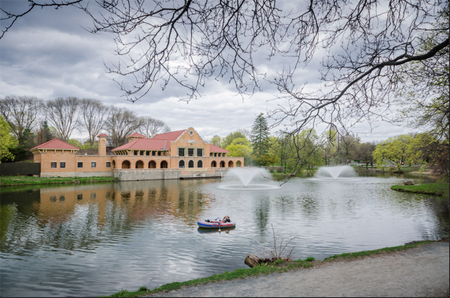 The Beaverkill Daylighted: Washington Park Lake
The Beaverkill Daylighted: Washington Park Lake
That’s a question I’ve been asking for a long time. Somewhere between the lake and the aeration grate the Beaverkill storm drain line is collecting flushed toilet water full of shit. What’s the source? Albany Medical Center? The Park South neighborhood, all those new buildings along New Scotland Avenue? The Veteran’s Hospital utility plant? Hackett Middle School? Or some line from a further neighborhood that connects unseen to the Beaverkill?
There is only one proper solution to this problem, to build a new sewer line from where the Park South neighborhood begins across Madison Avenue from Washington Park Lake all the way down either to the existing sewage treatment plant near the Port or to a new treatment plant built to accommodate the sewage generated by all this new construction and the ongoing expansion of Albany Med, a plant built at a site where it does not inconvenience citizens and their homes or sacrifice dedicated park land.
But I have been told that building a new sewer line is impossible because it would cost well over a billion dollars. That money is not available. The unspoken assumption is that those of us who live in the City of Albany are not worth such an expenditure. Therefore we should be grateful for getting a half-assed solution that takes care of the stink in the park and stops mats of shit from floating into the Hudson.
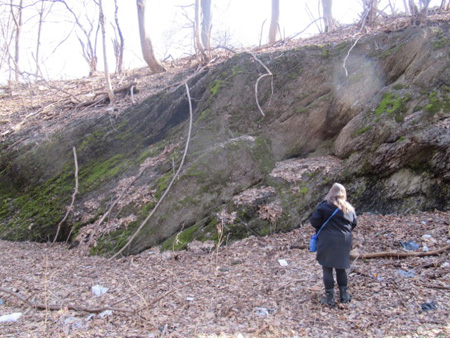 The Wife Checks Out The Rock Walls In The Ravine
The Wife Checks Out The Rock Walls In The Ravine
I can’t imagine that if we were talking about Clifton Park, or Delmar, or Loudonville that this would be floated as a solution. Somehow a billion dollars would magically appear and the overly expensive suburb would get the best sewer line available. And if they needed a sewage treatment plant it would be sited where it would inconvenience the rich suburban residents the least.
The other big problem with this proposal is that we will now have an ugly fenced off utility building taking away our park lands. By State law park land cannot be removed from use as a park unless it is properly “alienated,” which means that both houses of the State legislature have to approve it, the governor has to approve it, AND equivalent land must be found nearby that replaces the park land that is lost.
Commissioner Coffey does not feel that the alienation procedure is applicable in this case because it is a public works project, but our former Common Council member Dominick Calsolaro, who has experience with these matters, strongly disagrees with him. I have developed respect for Mr. Coffey’s enormous expertise and dedication to his frightfully complex job of wrangling the ancient underground pipes of Albany, his handling of the recent spectacular sewer cave-ins related to the Beaverkill on both ends of Washington Park Lake are examples of his abilities. I think the City was lucky to have someone that capable available to handle these crisis when they happened.
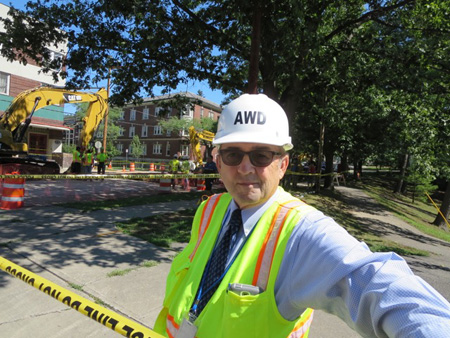 Albany Water Commissioner Joe Coffey At The Site Of The Elberon Street Sinkhole, August 2016
Albany Water Commissioner Joe Coffey At The Site Of The Elberon Street Sinkhole, August 2016
But Mr. Coffey is neither a politician or a lawyer. Approaching the problem as an engineer he has collected and analyzed the data and determined what looks to him to be the best practical solution with the resources available. So the inadequacy of the solution to this problem is not a failure on his part, it is a clever engineering solution under the circumstances.
Mr. Coffey’s employer, Mayor Kathy Sheehan, certainly deserves credit for tackling this decidedly unglamorous politically unappealing problem that no former mayor had enough backbone to deal with. It’s clear that she has a lot of financial balls to juggle and that she has to make decisions about what to prioritize based on the politics and the whims of the State governor. It’s not hard to see that if the State only presents enough money for a partial solution to the problem, that unless the mayor wants to start a war with the governor she has to take what is presented.
Meanwhile, the DEC has already given approval for the facility and the plan it is part of. But why doesn’t the State think we deserve a new sewer line? The State Thruway Authority had no problem spending over three quarters of a billion dollars to put a third lane between exits 23 and 24, an amenity that does not benefit our community in the least. Is not freedom from the looming threat of a health crisis worth a billion dollars? And isn’t a billion dollars something the State tosses around the way we regular folks spend $20 bills?
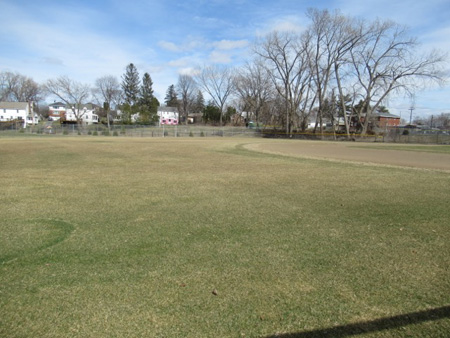 This Baseball Diamond At Woodlawn Park Can Hold 750,000 gallons of Beaverkill Runoff
This Baseball Diamond At Woodlawn Park Can Hold 750,000 gallons of Beaverkill Runoff
We need to consider that this treatment plant will not solve any sewage problems in the drainage area between Lincoln Park and Washington Park Lake. What happens when these drainage pipes fail in response to more building in Park South and beyond? What will happen to the new sewage treatment plant in Lincoln Park if the Beaverkill floods again during a heavy storm, as happened spectacularly in 2014?
Various projects have been built uptown that hopefully will catch excessive overflow from the Beaverkill during excessive storms. In a few places the drainage has been diverted away from the Beaverkill to other drain lines that can better handle a flood. And a water storage facility that can handle 750,000 gallons has been built out of sight underneath a ball field in Woodlawn Park. So hopefully we won’t have a repeat of the 2014 downtown flood, which was not the first but certainly the worst and an indicator of even worse floods to come.
But old pipes can and will fail when under stress. Just west of the ravine in Lincoln Park a stone’s throw from the stinking grate is a fenced off area. In 1994 a local fellow named Stanley “Shamar” Oliver was walking across the lawn when the ground gave way beneath his feet, plunging him into watery mud up to his chest. He managed to scramble out of the hole and immediately reported the new sinkhole to the authorities, But to this day he looks genuinely terrified when he tells the story and relives those moments.
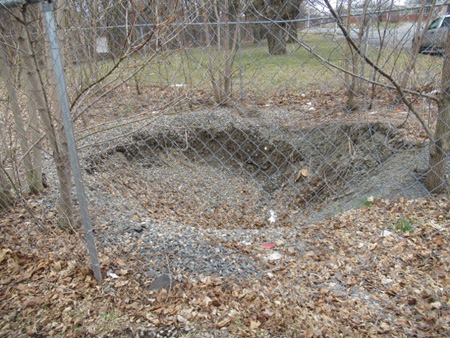 Sinkhole #1 Inside The Fence Above The Ravine
Sinkhole #1 Inside The Fence Above The Ravine
What Mr. Oliver discovered was the Beaverkill pipe collapsing deep underground. Immediately after this sinkhole formed, Washington Park Lake developed a noticeable smell of sewage, as was reported in the local newspapers. City crews dug frantically into Shamar’s sinkhole to try to open up the line again. I recall walking past and asking the guys in the crew what they were doing, and was rudely rebuffed, “Nothing, don’t worry about it.” I don’t recall anyone at the time linking the two events, the sewage in Washington Park Lake and the sinkhole in Lincoln Park.
Recently I heard Mr. Coffey explain that in 1994 the crews digging into the sinkhole didn’t have equipment that would dig deep enough to reach the Beaverkill pipe. But somehow they managed to get the Beaverkill flowing again, and pretty quickly the sewage smell in Washington Park Lake dissipated. I have no idea what they did, but the problem was temporarily solved for the next quarter of a century.
But because outgoing mayor Thomas Whalen didn’t want to rent the equipment necessary to properly repair the pipe the break was left with the temporary repair, and a fence was installed around the area presumably so there would be no more hapless pedestrians sinking into the ground. In January of 1995 Jennings became mayor and for the next 20 years he did nothing to advance the repair of the pipe at that spot except put a new fence around it. There were a number of floods that happened along the Beaverkill during his reign, but somehow the former mayor managed to evade responsibility for neglecting the flooding problems.
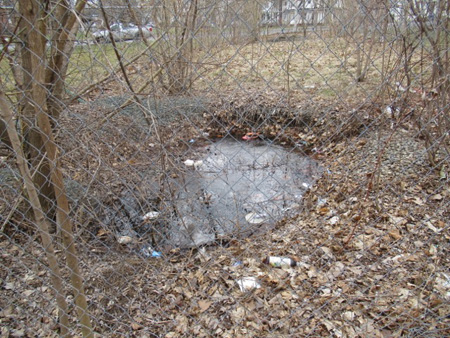 Sinkhole #2 Next To The Ravine
Sinkhole #2 Next To The Ravine
Today there are two big sinkholes inside the fence, one is filled with water. This past summer I noticed the ground collapsing in one spot, now the holes are threatening to widen past the chain link fence. Repairing this ancient temporary repair is part of the plan for siting the sewage treatment facility, but from the looks of it something will have to be done here a lot sooner than that.
It was in the first year that Ms. Sheehan was mayor that the big 2014 flood happened, the first big test of her crisis management skills. For several hours streets and homes were flooded in a big swath from Elberon Street which is west of Washington Park, across the South End all the way downtown to the waterfront, pretty much along the route of the Beaverkill, a path of ruination. On Broadway downtown people paddled canoes and rubber rafts across the parking lots among the half submerged cars.
In the weeks afterward Mayor Sheehan took immediate steps to come up with a plan to prevent this from happening again, and scheduled public meetings so people could ask questions and vent. But it seems she quickly decided that the best solution, building a new sewer line that can carry the increased level of sewage safely, was off the table. I’m not happy with that decision, but it appears I’m quite alone with my displeasure. I have yet to meet a public official, a concerned neighbor or anyone else who doesn’t immediately accept that it would be impossible for the City of Albany to get a billion dollars from the State to build a new sewer line.
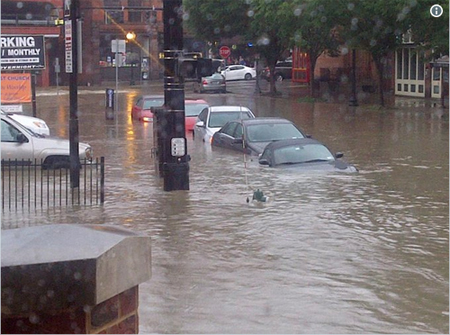 Sheridan Avenue Albany, August 2014
Sheridan Avenue Albany, August 2014
In fact, from what I’ve heard most people who live nearby think it’s a great idea to fill in the ravine because even though very few of them have ever ventured down into the ravine they consider it ugly and dangerous, a place where sketchy homeless people camp. As far as they are concerned this is a wasted space. They seem very happy with the idea of turning half of the ravine into some kind of public amenity after it is filled in.
On the first Saturday afternoon in April I took The Wife for a stroll into the ravine, walking around the fence behind the community garden along MLK Boulevard. Sure enough just behind the fence I saw what looked like a makeshift hut constructed of scavenged materials. There was some garbage strewn about but the ravine had been cleared of a lot of brush, so it was easy to walk back there without getting muddy.
It’s really a very nice spot with exposed rock walls on either side. It’s easy to see how this was once a tourist destination. With a little cleaning up and landscaping it could easily become a delightful garden spot again with a walking path. And, of course, eliminating that aeration grate stinking up the ravine.
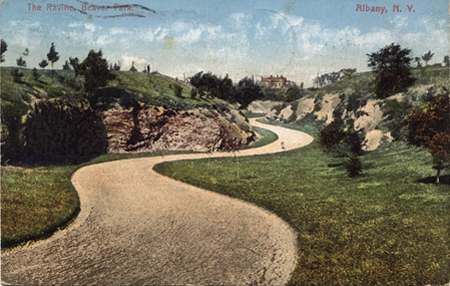 Postcard Of The Ravine Marked 1913, The Sewage Treatment Facility Will Go In The Foreground
Postcard Of The Ravine Marked 1913, The Sewage Treatment Facility Will Go In The Foreground
But as we walked back there I could hear the mighty Beaverkill roaring underground as we approached the grate. The Wife, who unlike me has a workable sense of smell, announced that she was not getting any closer to it because of the horrible odor wafting from it. And I noted that there were no signs of homeless people ever having habitated on this end of the ravine.
The only thing that is wrong with this ravine is the stinking grate functioning as a sewage gas vent, an aeration grate that makes it clear that the original intention was to use the Beaverkill as an illegal sewer line all along. Sometimes lots of water shoots out of the grate, during the 2014 flood a deluge poured out of the ravine and drowned the garden and blocked MLK Boulevard. We are being promised that if this facility gets built here then there will be no more floods pouring out of the ravine, or rather, out of the new facility. I guess we’ll see.